| Western History Collections University of Oklahoma Libraries |
 |
| White Bull |
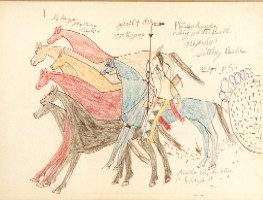 When White Bull was 16 years old, he went on his first warpath to raid an encampment of U.S. soldiers near the Big Horn Mountains. On this raid he captured horses from the encampment of soldiers, which is represented by the circle filled with dots. WHITE BULL 1 |
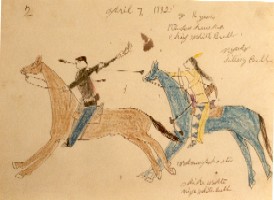 White Bull depicts himself counting coup on a U.S. Indian scout. He then shoots the scout with an arrow. This was the first time White Bull counted coup on an enemy WHITE BULL 2 | |
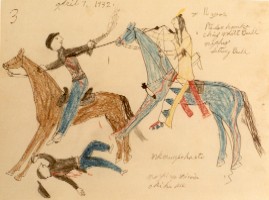 In this scene, White Bull lances and unhorses a U.S. Indian Scout, counting his first "first" coup. The enemy is first seen in the saddle when struck, then dead on the ground. WHITE BULL 3 |
 White Bull again obtains a first coup as he lances and unhorses another U.S. Indian scout. WHITE BULL 4 | |
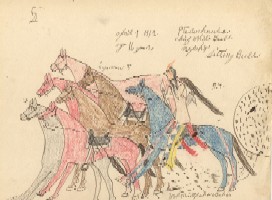 White Bull captures six horses from U.S. Indian scouts. White Bull depicts the scouts' camp by a circle with dots indicating enemies. The line of dashes represent tracks made by the horses of White Bull and his pursuers. WHITE BULL 5 |
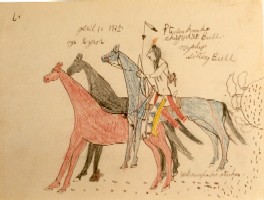 White Bull pictures himself stealing two horses from U.S. soldiers. White Bull depicts the soldiers' camp by the circle full of dots. Puffs of rifle smoke can be seen coming form the soldiers' camp. WHITE BULL 6 | |
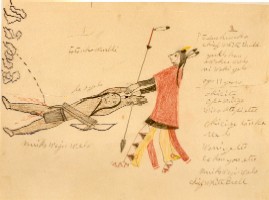 At the Fetterman battle, White Bull rescues the wounded warrior Bull Eagle. Clouds of smoke indicate the position of Fetterman's command, from which a dotted line marks the path of the bullet that wounded Bull Eagle. WHITE BULL 8 |
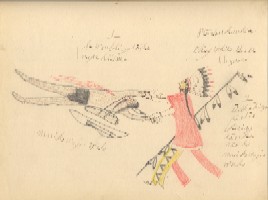 In this scene, White Bull rescues his friend Hairy Hand (Sitting Eagle), who was shot by the soldiers defending their position in the wagon boxes. WHITE BULL 9 | |
 In this drawing, White Bull is first to strike enemy Indian whom he scalps. The enemy Indian is first shown running away and then on the ground with the scalp knife at his head. WHITE BULL 10 |
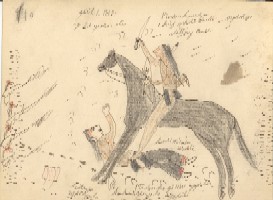 White Bull was first to strike the Crow who was carrying the medicine bundle containing the white buffalo hide. The bundle is shown lying on the ground. WHITE BULL 12 | |
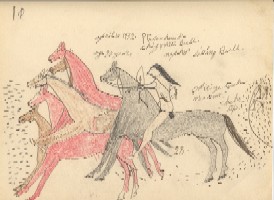 White Bull captures five horses form an Assiniboine camp. The Assiniboine camp is indicated by the circle and tents. WHITE BULL 13 |
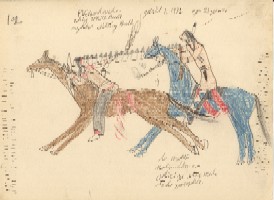 White Bull depicts himself striking a Flathead with his lance and shooting the enemy's horse. A first coup, White Bull stated, "I struck this Flathead in the fight, I was first to strike him." WHITE BULL 14 | |
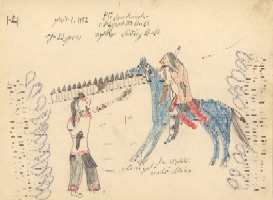 White Bull uses his lance to strike a Flathead who is armed with a rifle. The Flathead fired at White Bull and the bullet broke White Bull's lance. This is considered one of White Bull's bravest acts against an enemy. WHITE BULL 15 |
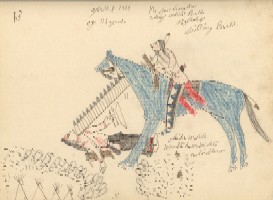 This drawing depicts White Bull as he counts coup on a fallen Flathead. White Bull stated "Pretty-Voiced-Eagle struck him first, I hit him second." The Flathead camp is also shown as the Sioux advance. WHITE BULL 16 | |
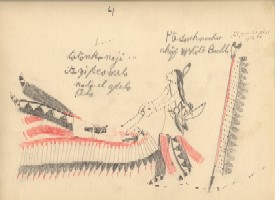 In this drawing, White Bull is shown wailing over his dead friend Standing Bull, who was killed in the battle against the Flatheads. In this battle, White Bull wore his war charm over his left shoulder. WHITE BULL 17 |
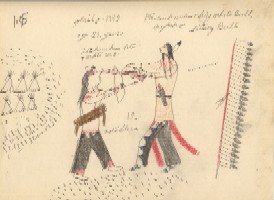 White Bull kills and scalps the Flathead who killed Standing Bull. On the right of White Bull is his discarded lance which was hit with a bullet. A Flathead arrow can be seen between White Bull and his lance, depicting the intensity of the battle. BULL 18 | |
| 1 . 2 . 3 | ||
Ordering Information | Price List Photograph Policies | Photograph Disclaimer White Bull Homepage | ||
| Gallery | ||
| Western History Collections Photographic Archives | ||
| Western History Collections | University Libraries OU Homepage | OU Visitors Center | ||
| Contact the Western History Collections. | ||
| disclaimer | ||